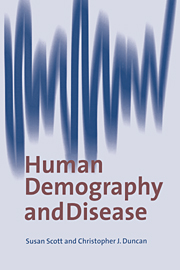Book contents
- Frontmatter
- Contents
- Preface
- Conversion table for imperial to metric units
- 1 Introduction
- 2 Tools for demography and epidemiology
- 3 Identification of population oscillations: a case study
- 4 Density-dependent control and feedback
- 5 Modelling the endogenous oscillations and predictions from timeseries analysis
- 6 Cycles in the grain price series
- 7 Interactions of exogenous cycles: a case study
- 8 Mortality crises and the effects of the price of wool
- 9 Modelling epidemics for the demographer: the dynamics of smallpox in London
- 10 Non-linear modelling of the 2-yearly epidemics of smallpox: the genesis of chaos?
- 11 Measles and whooping cough in London
- 12 Integration of the dynamics of infectious diseases with the demography of London
- 13 Smallpox in rural towns in England in the 17th and 18th centuries
- 14 Infectious diseases in England and Wales in the 19th century
- 15 Prospectives – towards a metapopulation study
- References
- Index
13 - Smallpox in rural towns in England in the 17th and 18th centuries
Published online by Cambridge University Press: 25 January 2010
- Frontmatter
- Contents
- Preface
- Conversion table for imperial to metric units
- 1 Introduction
- 2 Tools for demography and epidemiology
- 3 Identification of population oscillations: a case study
- 4 Density-dependent control and feedback
- 5 Modelling the endogenous oscillations and predictions from timeseries analysis
- 6 Cycles in the grain price series
- 7 Interactions of exogenous cycles: a case study
- 8 Mortality crises and the effects of the price of wool
- 9 Modelling epidemics for the demographer: the dynamics of smallpox in London
- 10 Non-linear modelling of the 2-yearly epidemics of smallpox: the genesis of chaos?
- 11 Measles and whooping cough in London
- 12 Integration of the dynamics of infectious diseases with the demography of London
- 13 Smallpox in rural towns in England in the 17th and 18th centuries
- 14 Infectious diseases in England and Wales in the 19th century
- 15 Prospectives – towards a metapopulation study
- References
- Index
Summary
Smallpox was a lethal infectious disease and was persistent in England throughout the period 1600–1800; perhaps 20% of smallpox victims died (although a very much higher mortality in London in the 18th century is suggested by the modelling in Chapter 12) and the survivors retained an immunity for many years. Evidence suggests that a particularly virulent strain began to afflict people of all ages and social backgrounds in the middle and later decades of the 17th century.
When smallpox was fully established in large conurbations (with high N/β) it was endemic and was characterised by 2-yearly epidemics, the evolution of which, from 4-yearly through 3-yearly epidemics, can be traced clearly in London (section 9.5) and Chester (section 10.2). It has been suggested that smallpox was also endemic in such cities as Nottingham, Chester, Northampton, Norwich, and Manchester after 1725 and before it was brought under control by inoculation and then by vaccination (Mercer, 1985). There are no long runs of data for deaths or cases of smallpox in rural England outside the major cities during the 17th and 18th centuries, although there are sporadic references to smallpox deaths in many parish registers and many accounts of outbreaks of smallpox in rural England in the 18th century (Creighton, 1894; Razzell, 1977), but this does not necessarily mean that the disease was endemic; indeed, accounts of spectacular outbreaks with widespread mortality indicate a population that had not recently experienced the disease and in which most individuals were susceptible. An example is the outbreak in the Island of Foula (Shetland Islands) in 1720, where only about six persons survived out of a population estimated at 200 (Razzell, 1977).
- Type
- Chapter
- Information
- Human Demography and Disease , pp. 270 - 302Publisher: Cambridge University PressPrint publication year: 1998



